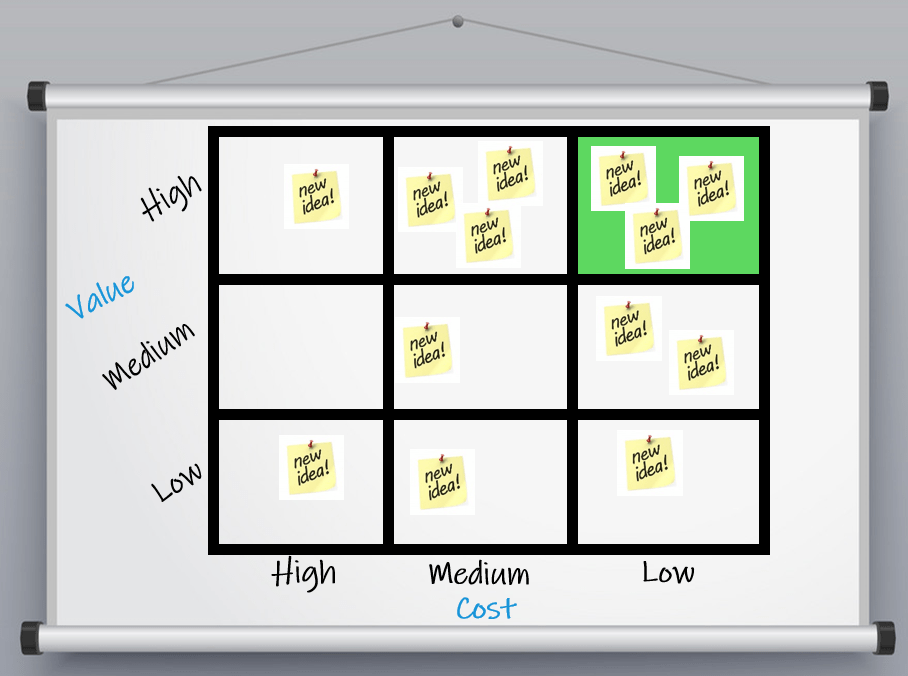PEOPLE
2+ depending on the size of the team.
TIME
30-60 minutes per activity. No one wants to be in a meeting longer than needed. Try to keep it short and sweet.
NINJA LEVEL
Novice to Master. Anyone can improve leadership skills and master this play!
PREP WORK
PLACE
Virtually or in-person it is critical that everyone has face-time with each other. So make sure that if attending virtually that everyone can connect in video chat. You will also need to share ideas, so a whiteboard is important and a space that fosters creativity and innovation.
THE PLAY
All of our plays are five steps or less! However, you may need to run multiple plays to get the most out of this one. Don’t worry – you can do it! Learn the play, rehearse it regularly, apply it in the field and debrief on the outcomes. If it worked well, use it again; if it didn’t, find out why. Are there new factors in the system you need to consider, or do you just need to keep practicing? If you need help or have questions on this play, contact us!
01
SET THE STAGE
Who are the players?
Every winning team knows which players to have on the field and what talent you need on the ready. To successfully deploy this play you will need the following roster:
![]() Leader: Likely this is you! In football this is the coach. Good leadership is about acquiring and honing specific skills. Leadership skills enable you to be a role model for a team in any environment. Some of the skills needed:
Leader: Likely this is you! In football this is the coach. Good leadership is about acquiring and honing specific skills. Leadership skills enable you to be a role model for a team in any environment. Some of the skills needed:
- A positive attitude.
- Confidence.
- A sense of humor.
- Ability to embrace failure.
- Careful listening and feedback.
- Knowing how and when to delegate.
- Growth mindset.
- Responsibility.
- A desire to learn.
![]() Team Players: This is someone who actively contributes to the team in order to complete tasks, meet goals or achieve outcomes and results. Every organization relies on good teams. Skills needed:
Team Players: This is someone who actively contributes to the team in order to complete tasks, meet goals or achieve outcomes and results. Every organization relies on good teams. Skills needed:
- Communicate effectively.
- Is the 3R’s: Responsible, Reliable and Ready
- Optimistic and future-focused.
- Shows genuine commitment.
- Supports and respects others.
- Embraces collaboration.
- Actively listens.
- Problem solver.
02
CORE ACTIVITIES
SHOW THAT YOU CARE
Being a good leader means caring about the people you’re leading. Of course, caring about your people seems so obvious. Every leader must communicate that they care about their people. But caring is about actions, not just words. Here are some ways to show that you care:
- Get personal. This means taking an interest in your team beyond an employee ID and knowing basic information. This can be uncomfortable for some and may be a stretch, but to inspire someone must mean that you know and understand them. Start with one-on-one conversations. It is crucial to create a safe space in one-on-one meetings. Beyond covering work updates and small talk, aim to learn about the person. Assure them that the conversation is confidential and will not be shared without permission. No matter what is discussed or mentioned do not get defensive, angry, or dismissive. This is not a debate, you are there to understand. As a leader and manager, team member safety is your responsibility and your prime directive.
- Connect the dots. The team needs to know how their work contributes to the larger goal. Take time to understand the day to day work of your team. A regular team strategy meeting is an opportunity for alignment between the team and the organizational goals. Review individual contributions with the team and opportunities within the goals of the organization to be part of the winning team. Listen to their ideas and implement them in a timely manner. Learn from them and when something works, give them credit with the larger organization. This also will demonstrate to the team that you care about their success as well as the organization.
- Measure what matters. Different organizations will have different definitions of what matters. For most teams, it is more meaningful to measure achievements rather than actions, although harder to measure. It is easier to count how often someone performs a function, but if that activity doesn’t result in a valuable outcome, why count it at all? OKRs (Objective & Key Results) are a framework that measure results and how that aligns to bigger objectives. Start small with this framework and after success, grow to include larger organizational goals.
BUILD PEOPLE UP
The key to this is being authentic and trustworthy. Without those two characteristics no amount of build up will inspire the team. In fact, it will have the opposite effect and the team will question your motives. Whether you’re on-boarding entry-level hires or working with a long-standing team, here are ways that managers of all experience levels can develop a strong, cohesive team.
- Ensure that each person truly understands their role. This goes beyond a job description and a training manual. This is the understanding of the functions of that role and how they contribute to the goals of the organization.
- Provide training and development tools. Create a learning culture on the team. Constantly feed the curiosity of the person with challenging problems and empower them to learn the solution without being told it. Coach from the sideline and resist the temptation to get out on the field yourself. Inspire them to learn the skills for mastery of their role.
- Game plan for their growth. See the next step in their career path. Work yourself out of a job and prepare your team to step into your role. This may seem counterproductive to team building, however, it demonstrates to the team that you see potential in them. You believe in their ability to do more. Review their career development plan regularly and celebrate progress along the way. Development is a continual process and, if done across the organization, it ensures a steady flow of leaders moving up through the organization.
LISTEN WITH EMPATHY
Emphatic listening is a skill that can be learned and practiced and is key to great leadership and effective communication skills. It is easy to hear things or passively listen while multitasking. It is difficult to really listen with empathy. Empathic listening is essential to your success as a leader. Regardless of the industry you work in, empathic listening is a great skill to improve. Here are some way to improve your listening skills:
- Find areas of common interests by creating a positive attitude to the topic. This is the time for common ground, do not take the stage to talk about how you also had a similar story. Instead acknowledge their unique perspective and build on shared interest.
- Take the initiative to find out what the speaker knows. Seek to understand. Ask open ended questions and inquire about topics you don’t know yourself. Continue to find out more without taking the conversation to what you know on the subject.
- Avoid judging or jumping to solutions early and keep a neutral mind set. Leaders are great problem solvers, but empathetic listening requires you to resist solutioning or drifting off to problem solve while the person is talking. Keep yourself focused on fully listening to the person.
- Focus on the speaker’s ideas and keep an open mind. Go into the situation with the possibility that you may not know the outcome of the conversation. This mindset will help you keep focused on the speaker instead of waiting for a time to talk yourself.
- Be curious about other people and their position and their ideas, even if it is contrary to your position. Express your curiosity and create a safe space for discussion of topics that may differ from your own point of view. This shows that you understand the other’s perspective on the topic.
TREAT PEOPLE WITH RESPECT
“Every human being, of whatever origin, of whatever station, deserves respect. We must each respect others even as we respect ourselves.” — Ralph Waldo Emerson
When employees feel genuinely respected by their boss, they are more likely to work hard, stay loyal and go the extra mile when the going gets rough. They’re also going to be more respectful to others, including their bosses, colleagues and customers. However you can’t just say you are respectful, you must show it. Here are ways a leader can demonstrate respect:
- Welcome all opinions, ideas and feedback. This is just as important for those ones you don’t agree with as the ones you do. This means pulling everyone into the conversation whether or not they speak up.
- Be curious and compassionate. Stay curious, even when you think you understand the situation or answer. Don’t assume you know how it feels, ask and be compassionate to their point of view.
- Be present and attentive. Put your phone down, close your computer screen, set Do Not Disturb status on. Whatever it takes to remove distractions so that you can be fully present during time with your team.
- Trust your team. Show them that you trust them. Give them assignments that demonstrate it. Don’t hoover or micro-manage them. Create safe space for them to fail and support them in trying again. Take of the training wheels, and see them sore.
- Make your word gold. If you say it, mean it. Don’t promise things you cannot deliver, don’t be wishy on commitment, and be accountable when you make a mistake. Own up to it, and give your word to do your best to do better.
SHOWCASE THEIR STRENGTHS
Great leaders rarely take credit for their successes.
Instead, they pay homage to their colleagues and employees. Humility is a sign of a great leader, and great leaders know that true professionals are driven by a pride of workmanship. For many American professionals, receiving acknowledgment and credit for good work oftentimes supersedes any form of monetary reward or elevation in status. Here are some ways to showcase the team:
- Let the team present their work in senior leadership or executive meetings. Rehearse with them ahead of the meeting so they feel comfortable presenting. Set expectations with the meeting audience and the team. Don’t hesitate to frame it as a learning experience.
- A team or department newsletter showcasing recent accomplishments by the team. Make sure the team member authors a summary of the work that should be included in the announcement.
- Demo day! Each team member gives a brief overview demonstration of recently completed work. It is critical that the presenter is the creator, as this showcases their work.
Want to learn more about making your meetings a safe space for honest conversation? Check out this article by HBR.
More information about one-on-one meetings? This do’s and don’ts article is a great resource.
03
 TEAM HUDDLE
TEAM HUDDLE
Time to run the Team Huddle play. Ask the team the following questions and then take a vote. Keep follow-up questions to a minimum and capture any issues raised as an offline follow-up (and be sure to follow-up).
Understand the play?
![]() The play was understood and I asked any questions in time!
The play was understood and I asked any questions in time!
![]() I’m not sure I understand and I have some questions …
I’m not sure I understand and I have some questions …
![]() I did not understand the play or my part in it.
I did not understand the play or my part in it.
Did you get in the game?
![]() Yes, I made my moves and was in the right place at the right time!
Yes, I made my moves and was in the right place at the right time!
![]() I’m not sure I understand what I was supposed to do …
I’m not sure I understand what I was supposed to do …
![]() I kept the bench warm and watched from the sidelines.
I kept the bench warm and watched from the sidelines.
Ready for what’s next?
![]() Yes, I know the game plan and ready to win!
Yes, I know the game plan and ready to win!
![]() I’m not sure what’s next or if I am involved …
I’m not sure what’s next or if I am involved …
![]() No clue what’s next and would rather sit it out.
No clue what’s next and would rather sit it out.
04
NEXT STEPS
Continue to work on the skills and activities that inspire teams. Celebrate the wins and recognize the team for learning with you on how to improve.

05
IT’S A WRAP
You did it! Now just a few follow-up items:
- Reflect on the play. Ask yourself how it went? What could have gone better, what could have gone worse? In sports this is watching the game again to see any plays that could have been better. Update your playbook. Build feedback loops that help you see what’s working; what’s not; and how to continue to develop the playbook by learning, adapting and iterating constantly as situations change and new challenges arise.
- Contribute to the community of Playbook.Ninja. Sign-up for an account and receive updates on when new plays are added and help others by commenting on the plays with what worked or your experience.
Thank you for being a Playbook.Ninja
![]()


 TEAM HUDDLE
TEAM HUDDLE
 Villain Alert
Villain Alert


















